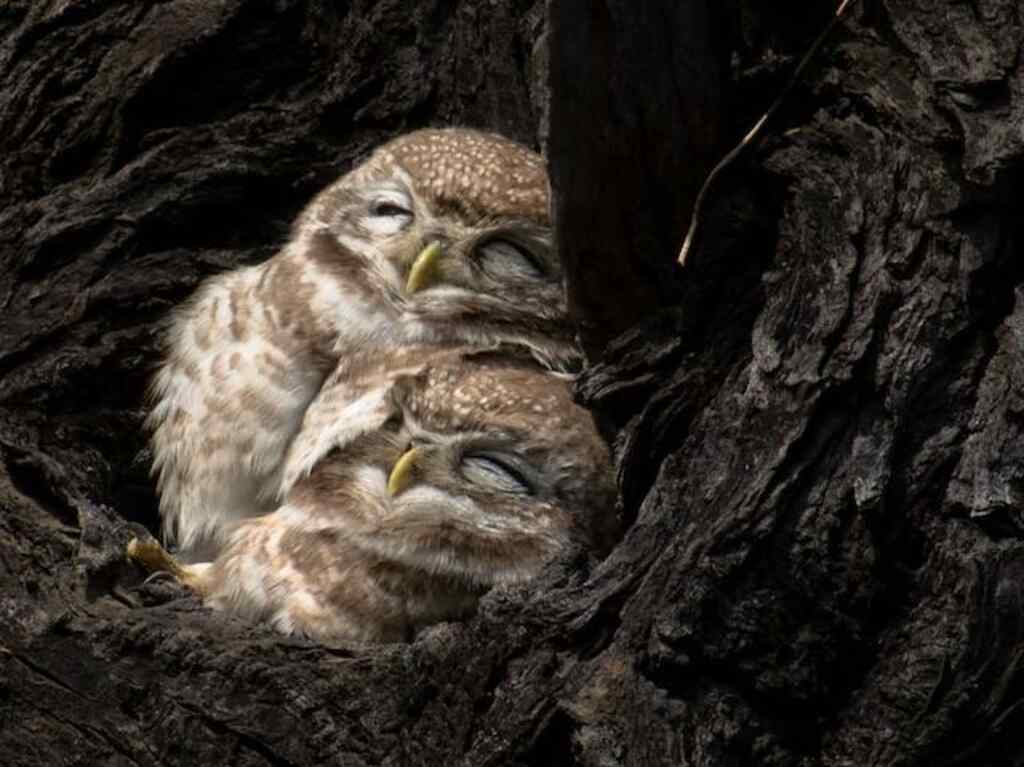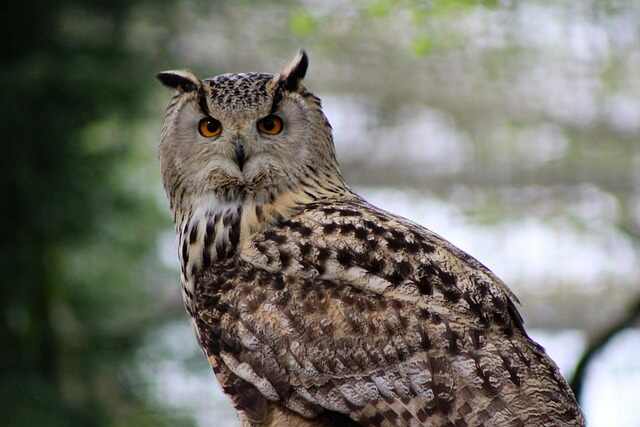Welcome to our exploration into the intriguing world of owl hibernation habits. As we delve deeper into the lives of these enigmatic creatures, we uncover the mysteries behind their seasonal behaviors. Join us on this journey of discovery as we seek to understand how and why owls navigate through the challenges of hibernation.
Table of Contents
- 1 Definition of Hibernation:
- 2 Overview of Owls and Their Habits:
- 3 Do Owls Hibernate?
- 4 Owl’s Winter Survival Techniques
- 5 Types of Owls That Hibernate
- 6 The Role of Climate Change in Owl Hibernation Patterns
- 6.1 How climate change affects the natural habitat and behavior patterns of owls.
- 6.2 Impact on Food Sources and Survival Techniques
- 6.3 The Importance of Understanding Hibernation Patterns For Conservation Efforts
- 6.4 Understanding Hibernation Patterns for Conservation Efforts
- 6.5 The Importance of Owl’s Unique Survival Techniques
- 7 FAQs About Do Owl’s Hibernate?
- 8 Do all birds hibernate?
- 9 Author
Definition of Hibernation:
Hibernation is a state of inactivity or dormancy that animals enter during winter months, usually characterized by a significant decrease in body temperature, heart rate, and metabolic activity.
The purpose of hibernation is to conserve energy when food sources become scarce due to harsh weather conditions or other environmental factors.
During hibernation, animals typically reduce their metabolic rate by up to 90%, allowing them to survive for an extended period without food.

Overview of Owls and Their Habits:
Owls are members of the Strigiformes order and inhabit nearly every corner of the globe, except for Antarctica. They are famous for their unique characteristics such as an erect stance, big front-facing eyes, powerful talons for hunting in darkness, and the ability to swivel their heads almost 270 degrees.
Owls are primarily nocturnal predators who hunt small mammals like rats, mice, rabbits as well as insects like moths. Owls have developed unique adaptations that allow them to survive in various environments around the world.
Their feathers provide excellent insulation against cold temperatures while allowing silent flight, necessary for catching prey unnoticed at nighttime. Furthermore, owls have highly developed senses such as hearing, which allows them to locate prey based on sounds made by movement.
This article will explore the hibernation patterns of owls, including whether they hibernate or not, their winter survival techniques, types of owls that hibernate and the impact of climate change on their behavior.
Owls are intriguing creatures with many fascinating characteristics that make them stand out from other birds. The next section will delve into the question of whether owls hibernate or not during winter months.
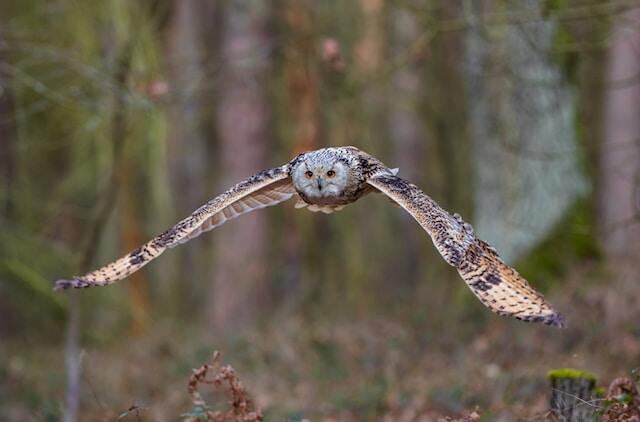
Do Owls Hibernate?
Explanation of Owl’s Behavior During Winter Months
Owls are highly adaptable birds of prey that have evolved various strategies to survive the cold winter months. While some species of owls migrate to warmer climates during winter, many species remain in their habitats and endure the harsh conditions.
During this period, owls must conserve energy and find food sources to sustain themselves. To conserve energy, owls slow down their metabolic rate and reduce their physical activity.
They also fluff up their feathers to create an insulating layer that traps warm air close to their bodies. This helps them maintain body heat and stay warm even in freezing temperatures.
Moreover, owls seek shelter in protected areas such as tree cavities or burrows to avoid exposure from harsh winds and snowfall. They also roost during the day and become more active at night when it is relatively warmer.
here’s a table listing different owl species and their torpor/hibernation habits:
| Owl Species | Torpor | Hibernate | Does Not Hibernate |
|---|---|---|---|
| Burrowing Owl | Yes | No | – |
| Long-eared Owl | Yes | No | – |
| Northern Saw-whet Owl | Yes | No | – |
| Short-eared Owl | Yes | No | – |
| Snowy Owl | Yes | No | – |
| Barn Owl | – | No | Yes |
| Eastern Screech Owl | – | No | Yes |
| Great Horned Owl | – | No | Yes |
| Northern Pygmy Owl | – | No | Yes |
| Western Screech Owl | – | No | Yes |
Comparison to Other Animals That Hibernate
Owls are not classified as true hibernators because they do not experience a significant drop in body temperature or heart rate compared to other animals that hibernate, such as bears or ground squirrels.
However, they do exhibit similar traits of torpor, which is a state of decreased physiological activity characterized by lowered body temperature and metabolism.
Unlike other hibernating animals, owls wake up periodically during torpor periods to hunt for small prey such as rodents or insects. This helps them maintain sufficient energy levels needed for survival in winter conditions.
Scientific Research on Owl’s Hibernation Patterns
Research on owl’s hibernation habits is limited due to the difficulty in studying them during this period. Nevertheless, studies have shown that different owl species exhibit varying patterns of torpor during winter months depending on factors like food availability, climate conditions, and predator pressure.
For instance, some owl species such as the snowy owl remain active throughout the winter months due to abundant food sources in their habitat. Other species like the great horned owl reduce their activity and become more sedentary during this period.
Scientific research has also shown that climate change is likely to affect owl’s hibernation patterns by altering their natural habitats, disrupting food sources, and affecting breeding patterns.
Therefore, understanding owl’s hibernation patterns is critical for conservation efforts aimed at protecting these magnificent birds of prey.
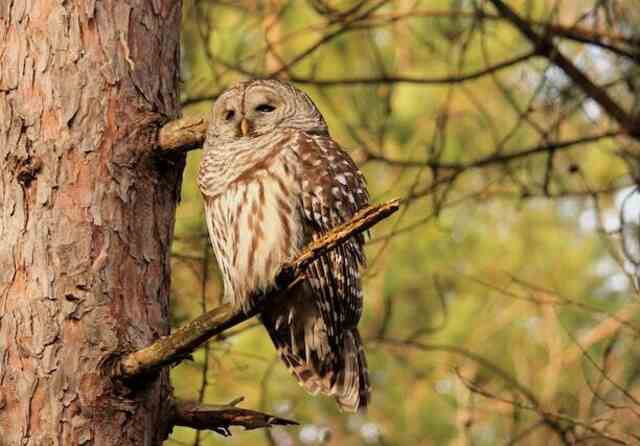
Owl’s Winter Survival Techniques
Adaptations for Cold Weather
Owls are known for their remarkable adaptations to help them survive during the winter months. One of these adaptations is specialized feathers that provide insulation from the cold.
These feathers are much denser than those of most other birds, which helps to retain heat close to the body. Additionally, owls have a unique feather structure that allows them to fly silently, even in deep snow, which is important when hunting in the winter.
Another adaptation is their ability to lower their metabolic rate and body temperature during periods of cold weather. By conserving energy in this way, owls can survive on less food and expend less energy during times when food may be scarce.
Hunting Strategies During Winter Months
During the winter months, prey can be scarce and difficult to locate, especially for nocturnal predators like owls. To maximize their chances of survival, many species of owl will start hunting earlier in the evening or later into the morning than they would during other times of year.
They may also change their hunting tactics by targeting different prey species or using different methods to catch their prey.
Some species of owl will rely on caching or storing prey items when food is abundant so that they have a reserve to draw from when prey is scarce.
Owls may hide extra food items under snow drifts or in tree cavities so that they can retrieve them at a later time.
Importance of Food Sources
Food sources are critical for owl survival during the winter months. Different species of owls have different dietary requirements and preferences, but all must be able to find enough food to sustain themselves through the winter.
In some areas where food sources are scarce, owls may need to travel further distances than usual or turn towards alternative prey items. This can lead to increased competition between individuals and even between different species of owl.
It is also important to note that changes in the availability of food sources due to climate change or habitat destruction can have a significant impact on owl populations. Understanding how owls adapt to changing food sources and environmental conditions can be critical for conservation efforts.
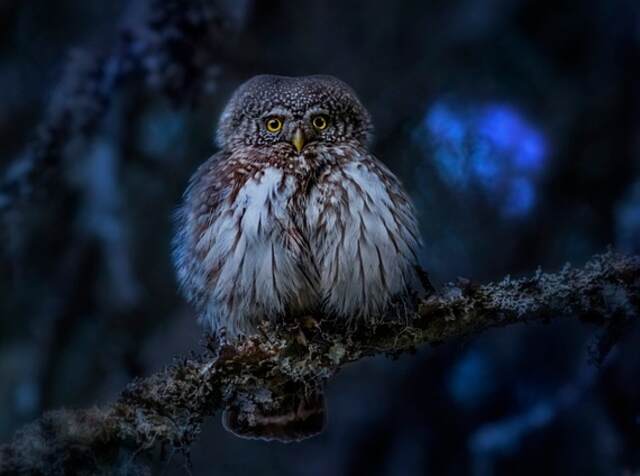
Types of Owls That Hibernate
The Great Horned Owl
The Great Horned Owl is one of the most common species of owls in North America. During the winter months, they often hunt at night and rest during the day to conserve energy.
They have a thick layer of feathers that keeps them warm during cold weather, and they also have the ability to fluff their feathers to create pockets of air that help retain heat.
In terms of hibernation patterns, Great Horned Owls are considered facultative hibernators, meaning that they only hibernate when food sources are scarce.
They may become inactive for several days or weeks at a time, but they do not enter a true state of hibernation like some other animals do.
The Northern Pygmy Owl
The Northern Pygmy Owl is a small species of owl that is found in mountainous regions across North America. During the winter months, they rely heavily on their hunting skills to find enough food to survive.
They are able to hunt during both day and night and have been known to take down prey much larger than themselves.
Like many other species of owls, Northern Pygmy Owls do not enter a state of true hibernation. However, they may become less active during periods when temperatures drop significantly or when food sources become scarce.
The Snowy Owl
The Snowy Owl is perhaps one of the most well-known species of owls due to its striking appearance and frequent appearances in literature and pop culture. They are found across Arctic regions around the world and have unique adaptations that allow them to survive in extremely cold temperatures.
During winter months, Snowy Owls will typically stay active throughout the day, since there is little darkness in Arctic regions during this time.
They rely on their excellent eyesight and hunting skills to find prey, which can include rodents, birds, and even fish. When it comes to hibernation patterns, Snowy Owls are considered to be partial hibernators.
This means that they may enter a state of decreased metabolic activity during periods of severe weather or when food sources are scarce. However, they do not enter a true state of hibernation like some other animals do.
Overall, different species of owls have unique behaviors and adaptations that allow them to survive during harsh winter months in various ways.
The Role of Climate Change in Owl Hibernation Patterns
How climate change affects the natural habitat and behavior patterns of owls.
Climate change has become a significant issue globally, affecting various habitats and ecosystems. As temperatures rise, it affects many animals’ natural behavior patterns, including the hibernation patterns of owls.
Owls are adapted to living in areas with cold winters and ample food sources; however, climate change is altering these critical factors. As temperatures continue to increase, there is a shift in the timing and duration of winter seasons.
This results in an inadequate amount of time for owls to prepare themselves for hibernation adequately. In turn, this affects their survival rates during winter months.
Additionally, climate change can affect precipitation levels resulting in changes to food availability for owls. Owls rely heavily on small mammals like rodents as their primary food source during winter months; however, changes in precipitation can impact rodent populations resulting in less prey available for owl’s survival.
Impact on Food Sources and Survival Techniques
Owls have various survival techniques that they use to get through tough winters successfully; however, these techniques may not be enough against the impact of climate change on their food sources.
Changing temperatures can result in delayed plant growth that impacts prey populations negatively. Furthermore, warmer temperatures may cause some species’ migrations that result in less prey availability for owls during winter months.
With lower amounts of prey available than usual during harsh weather conditions like cold winters or droughts caused by climate change, an owl’s chances of surviving diminish substantially.
As such changes occur steadily over time due to environmental factors caused by climate change, it becomes challenging for owls to adapt quickly enough without negative consequences long-term.
The Importance of Understanding Hibernation Patterns For Conservation Efforts
It is essential to understand the hibernation patterns of owls because they provide valuable insights into the ecosystem they inhabit. As climate change continues to impact habitats, studying owl hibernation patterns allows scientists to learn more about specific adaptations and changes that may occur.
With this knowledge, conservation efforts can be better tailored to protect owls and their habitats. Furthermore, by understanding the impact of climate change on owls’ hibernation habits and food sources, conservationists can implement strategies that help minimize its effect.
For instance, creating habitats with a stable food source or identifying areas where owls can thrive despite climate change impacts could go a long way in protecting these majestic birds.
Climate change has significant impacts on owl hibernation patterns resulting in critical consequences for their survival. It is crucial to study the role of climate change in owl behavior and adapt methods tailored towards minimizing its effects while preserving their habitat.
Understanding Hibernation Patterns for Conservation Efforts
It is fascinating to explore the unique behavior of owls during winter months. Although they do not hibernate in the traditional sense, they exhibit a variety of behaviors that allow them to survive harsh weather conditions.
Studying and understanding these behavioral patterns is essential for conservation efforts to help protect owl species and their habitats. By understanding how owls survive, conservationists can identify areas in which habitat destruction or other human activities could impact owl populations.
For example, changes in climate patterns have already affected owl populations by disrupting food sources and altering the timing of breeding activities.
Without a comprehensive understanding of how owls adapt to different environmental conditions, it is difficult to predict how they will be impacted by future changes.
The Importance of Owl’s Unique Survival Techniques
The unique survival techniques demonstrated by owls during winter months are not only fascinating but also provide valuable insights into how animals adapt to changing environmental conditions.
Owls’ ability to stay active throughout the year without hibernating sets them apart from many other creatures, making them an important subject for scientific research.
One notable adaptation that allows owls to survive harsh winters is their ability to store fat reserves before winter arrives.
By consuming large quantities of prey throughout the fall season, owls are able to build up enough body fat to last through colder months, when food sources may be scarce.
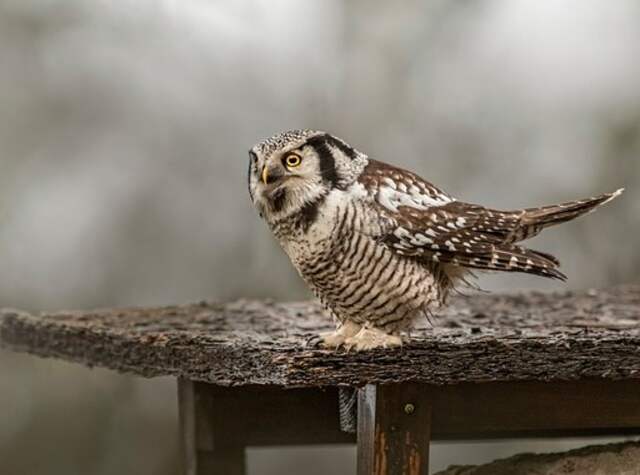
FAQs About Do Owl’s Hibernate?
Do all birds hibernate?
No, not all birds hibernate. Some birds, like owls, have the ability to enter a state of torpor, which is a form of deep sleep, but it’s not the same as hibernation.
Why don’t owls hibernate?
Owls don’t hibernate because they need to hunt and eat regularly to survive. Their bodies have adapted to allow them to cope with the cold and scarcity of food during the winter months.
What is torpor?
Torpor is a state of reduced metabolic activity that some animals, including owls, enter to conserve energy. During torpor, an animal’s heart rate, breathing rate, and body temperature decrease significantly.
Do all owl species behave the same way in winter?
No, different owl species have different behaviors in winter. Some species migrate to warmer areas, while others stay in their territories and adapt to the cold.
Do owls sleep during the day in winter?
Yes, owls sleep during the day in winter. Since the days are shorter in winter, they have more time to hunt and are more active at night.
How do owls cope with the cold?
To cope with the cold, owls possess several adaptations that aid them, including insulation-providing feathers, a low metabolic rate, and the capability to fluff up their feathers, which traps warm air close to their bodies.
Can I attract owls to my yard in winter?
Yes, you can attract owls to your yard in winter by providing food, water, and shelter. Building or installing an owl box can also encourage them to nest in your area. However, it’s important to research the specific needs of the owl species in your area before attempting to attract them.
Final Thoughts
It is evident that understanding owl’s winter survival techniques is critical for conserving these nocturnal birds of prey. While they do not hibernate like other animals, they exhibit unique behavioral patterns that allow them to thrive despite harsh weather conditions.
As we continue monitoring climate change and its effects on natural habitats worldwide, it will be essential to track how these changes impact wildlife like owls who depend on specific conditions to survive.
By studying these birds’ remarkable adaptations, we can learn not only about their behavior but also about the larger ecosystem in which they exist.
Ultimately, preserving these magnificent creatures will require a multifaceted approach that includes awareness, conservation efforts, and ongoing scientific research.
Related Post: Why Do Owls Hoot: Understanding Their Secret Language!

